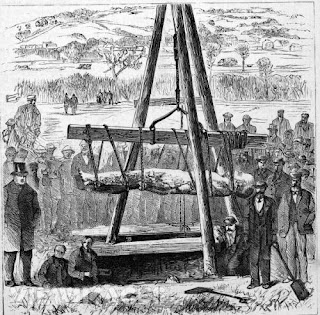It was forty years before the
Piltdown hoax was finally debunked but the fake known as the Cardiff Giant fell
apart in a matter of weeks. I have mentioned the blow to American national
pride caused by the remarks of the Comte de Buffon previously here, and the
subsequent search for the remnants of large American land animals, and one
explanation of the enormous bones found at Big Bone Lick, Kentucky in the 1740s
was that they were the remains of giants who had perished beneath the deluge of
Noah’s flood. Cotton Mather, in his vast Biblia Americana, wrote,
“The Giants that once Groan’d under the Waters, are now Found under the Earth, and their Dead Bones are Lively Proofs of the Mosaic History,”
echoing Job 26:5
“Behold the giants groan under the waters, and they that dwell with them.”
Joseph Priest, in his American Antiquities and Discoveries in the West (1835),
described the excavation of Indian graves in which were “… found several sculls
[sic] leg and thigh bones, which plainly shows that their possessors were
persons of gigantic stature.”
One evening in 1866, George Hull was in Ackley,
Iowa, chasing up his brother-in-law who was late in paying for a consignment of
cigars, when he got into an argument with Rev Mr Turk, a Methodist revivalist,
about the veracity of the Biblical tales of giants, particularly Genesis 6:4
“Now giants were upon the earth in those days,” which Rev Turk insisted was
literally true, whereas Hull, an atheist, denied it, saying it was metaphorical
at best. Hull settled on the idea of making a giant of his own, “I thought of
making a stone giant, and passing it off as a petrified man,” and found a large
block of gypsum in Fort Dodge, which, he told the quarrymen, was to be made
into a statue of Abraham Lincoln in New York.
The block was transported to
Chicago, where German sculptor Edward Burghardt was commissioned to carve the
giant. In a bid to add an aged patina, the figure was stained and a gallon of
sulphuric acid was poured over it, and Hull hammered darning needles into a
block of wood, which he used to pummel the appearance of pores onto the surface
of the stone. In November 1868, the finished piece, over ten foot long and
weighing over 3,000 lbs, was shipped to Hull’s home at Binghampton, and from
there to his cousin’s farm at Cardiff, New York.
 |
| The Cardiff Giant and a strategically placed branch |
William C ‘Stub’ Newell
secretly buried the figure behind his barn, and on October 16th
1869, he engaged Gideon Emmons and Henry Nichols to dig a new well at the point
he indicated. When they were three feet down, they struck stone and seeing a
foot, one of them shouted out, “I declare, some old Indian has been buried
here!”
 |
| Lifting the Giant |
Hull and Newell erected a tent over the ‘petrified man’ and charged
visitors 25c a head to see the marvel. Word spread and wagonloads of sensation
seekers arrived, so two days later the price of admission was upped to 50c.
 |
| The Cardiff Giant and friends |
Although Hull had sworn all involved to secrecy, he found out that Cousin
‘Stub’ had let word slip so, knowing that the truth would soon come out, he sold
his part-share to a syndicate of local businessmen for the sum of $23,000. On
November 5th 1869, the Cardiff Giant was unearthed and shipped to
Syracuse, where one eminent churchman declared “…we have here a fossilized
human being, perhaps one of the giants mentioned in Scripture,” although others
were not so easily beguiled - Yale palaeontologist Othniel C. Marsh pronounced,
“It is of very recent origin, and a most decided humbug.”
 |
| Phineas T Barnum |
The showman Phineas T
Barnum became interested in the Giant and offered to buy it from the syndicate
for $50,000, and when they declined to sell, Barnum sent an undercover artist
to make a surreptitious wax model of the figure.
 |
| The Dimensions of the Cardiff Giant |
From this, and using the
measurements taken from advertising flyers, Barnum had a plaster reproduction
of the Cardiff Giant made, which he exhibited at his museum in New York. David
Hannum, leader of the syndicate, expressed his opinion on the popularity of
Barnum’s copy with the words, “There's a sucker born every minute,” a phrase
often attributed to Barnum himself and happily appropriated by him later. The
syndicate sought a court injunction to stop Barnum’s exhibit, only to be told
by the judge, “Bring your giant here, and if he swears to his own genuineness
as a bona fide petrifaction, you shall have the injunction you ask for.” On
December 10th 1869, George Hull confessed all to the press and on
February 2nd 1870, the court ruled that both Giants were fakes, and
Barnum could not be sued for displaying a fake of a fake.
 |
| The Cardiff Giant |
The Cardiff Giant was
sold to a publisher from Des Moines, who sold it in 1947 to the Farmer’s Museum
in Cooperstown, New York, where it is now exhibited in a reproduction of the
original tent raised on ‘Stub’ Newell’s farm in October 1869.
 |
| Roll Up, Roll Up |

No comments:
Post a Comment